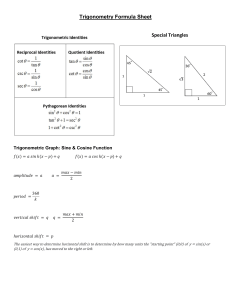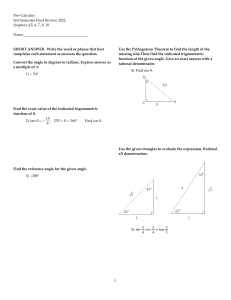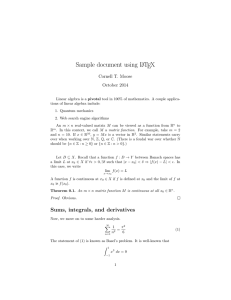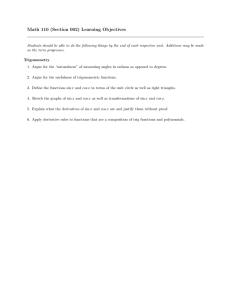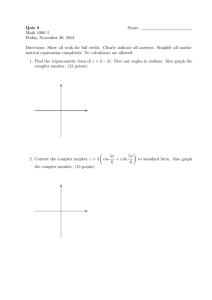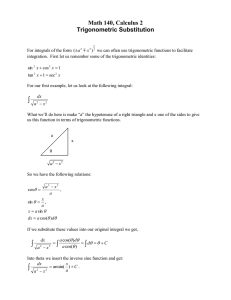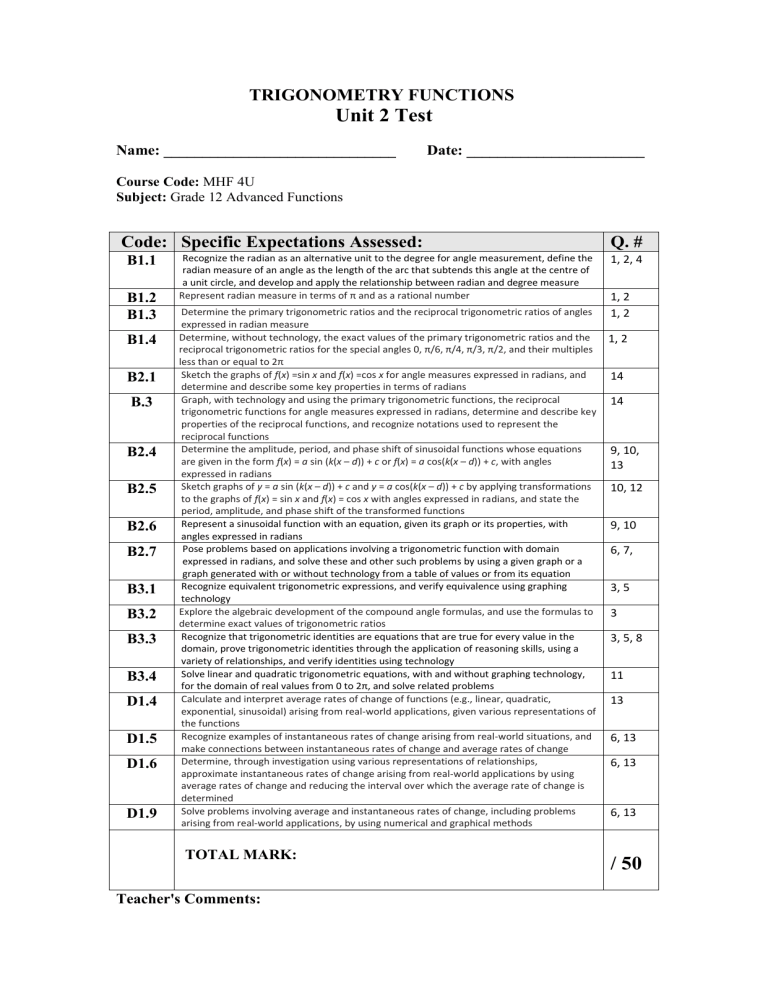
TRIGONOMETRY FUNCTIONS Unit 2 Test Name: ______________________________ Date: _______________________ Course Code: MHF 4U Subject: Grade 12 Advanced Functions Code: Specific Expectations Assessed: B1.1 B1.2 B1.3 B1.4 B2.1 B.3 B2.4 B2.5 B2.6 B2.7 B3.1 B3.2 B3.3 B3.4 D1.4 D1.5 D1.6 D1.9 Recognize the radian as an alternative unit to the degree for angle measurement, define the radian measure of an angle as the length of the arc that subtends this angle at the centre of a unit circle, and develop and apply the relationship between radian and degree measure Represent radian measure in terms of π and as a rational number Determine the primary trigonometric ratios and the reciprocal trigonometric ratios of angles expressed in radian measure Determine, without technology, the exact values of the primary trigonometric ratios and the reciprocal trigonometric ratios for the special angles 0, π/6, π/4, π/3, π/2, and their multiples less than or equal to 2π Sketch the graphs of f(x) =sin x and f(x) =cos x for angle measures expressed in radians, and determine and describe some key properties in terms of radians Graph, with technology and using the primary trigonometric functions, the reciprocal trigonometric functions for angle measures expressed in radians, determine and describe key properties of the reciprocal functions, and recognize notations used to represent the reciprocal functions Determine the amplitude, period, and phase shift of sinusoidal functions whose equations are given in the form f(x) = a sin (k(x – d)) + c or f(x) = a cos(k(x – d)) + c, with angles expressed in radians Sketch graphs of y = a sin (k(x – d)) + c and y = a cos(k(x – d)) + c by applying transformations to the graphs of f(x) = sin x and f(x) = cos x with angles expressed in radians, and state the period, amplitude, and phase shift of the transformed functions Represent a sinusoidal function with an equation, given its graph or its properties, with angles expressed in radians Pose problems based on applications involving a trigonometric function with domain expressed in radians, and solve these and other such problems by using a given graph or a graph generated with or without technology from a table of values or from its equation Recognize equivalent trigonometric expressions, and verify equivalence using graphing technology Explore the algebraic development of the compound angle formulas, and use the formulas to determine exact values of trigonometric ratios Recognize that trigonometric identities are equations that are true for every value in the domain, prove trigonometric identities through the application of reasoning skills, using a variety of relationships, and verify identities using technology Solve linear and quadratic trigonometric equations, with and without graphing technology, for the domain of real values from 0 to 2π, and solve related problems Calculate and interpret average rates of change of functions (e.g., linear, quadratic, exponential, sinusoidal) arising from real-world applications, given various representations of the functions Recognize examples of instantaneous rates of change arising from real-world situations, and make connections between instantaneous rates of change and average rates of change Determine, through investigation using various representations of relationships, approximate instantaneous rates of change arising from real-world applications by using average rates of change and reducing the interval over which the average rate of change is determined Solve problems involving average and instantaneous rates of change, including problems arising from real-world applications, by using numerical and graphical methods TOTAL MARK: Teacher's Comments: Q. # 1, 2, 4 1, 2 1, 2 1, 2 14 14 9, 10, 13 10, 12 9, 10 6, 7, 3, 5 3 3, 5, 8 11 13 6, 13 6, 13 6, 13 / 50 Name:______________________________ Date: _________________________ Unit 2 Trigonometry Functions Test 1. What is the exact radian measure of 105o? [K-1] 2. The exact value of cos (5π / 3) is: [K-1] 3. Use the appropriate compound angle formula to express as a single trigonometric function, and then determine an exact value for the expression. [T/C-4] 5 5 cos sin sin a) cos 12 4 12 4 cos 6 csc 3 sin 4 b) 4. Kitty's radian watch replaces the usual numbers around the face with radians. So instead of 12, it is 0. Instead of 6, it is π. The hour and minute hands of the watch run in the usual clockwise direction. a) What radian time corresponds to 8:30? [A/T-1] b) What normal time corresponds to a radian time of 15π / 4? [A/T-1] 5. Prove that [T/C-4] 1 sin 2 x sin 2 x a) cos x 2 sin x sin 2 x tan x b) 1 cos 2 x 6. The angular velocity of a wheel is the rate at which the central angle changes with respect to time. The wheel rotates at 8000 rpm (revolutions per minute). Determine its angular velocity, in a) degrees per second [K/A-2] b) radians per second [K/A-1] 7. David made a swing for his niece Sarah using ropes 2.4 m long, so that Sarah swings through an arc of length 1.2 m. Determine the angle through which Sarah Swings, in both radians and degrees. Include a labeled diagram. [A/C-3] 8. Given that csc a = sec 1.45 and that a lies in the first quadrant, use a cofunction identity to determine the measure of angle a, to two decimal places. [T/C-2] 9. Tarzan is swinging on a vine in the jungle. His height above ground with respect to time is modeled by the following sinusoidal function: [K/T/A-6] What is the equation of the sinusoidal axis? What is the period? What is the amplitude? What is a possible equation of the graph? ________________________ Approximately how high would Tarzan be after 90 seconds? _______ 10. Write the equation and sketch a sinusoidal function that meets all of the following criteria: Sinusoidal Axis (or Vertical Translation): y = 2 Period: 80o Amplitude: 4 [T/C-5] 11. Find the solutions on the interval [0, 2π] a) sec2x – 2tan2x = 0 b) 3sin2x – 8sinx – 3 = 0 [T-4] 12. Describe and sketch the transformations that when applied to the graph of y = cosx result in the graph of . [T/C-4] 13. The height, h, in metres, of a car above the ground as a Ferris wheel turns can be modelled using the function h = 15cos (πt/20) + 18, where t is the time, in seconds. [A/C-4] a) Determine the average rate of change between 15s to 20s. b) Estimate a value for the instantaneous rate of change of h at t = 20s. 14. Sketch the graphs of y = sinx and y = csc x on the same grid [-2π ≤ x ≤ 2π] and compare the key features between the two functions. [T/C-7] SIN X Period Amplitude X-Intercepts Y-Intercept Domain / Range Asymptotes? CHALLENGE: Prove: sec x 2(cos x sin 2 x sin x cos 2 x) sin 2 x TOTAL MARK: ___________ / 50 CSC X
